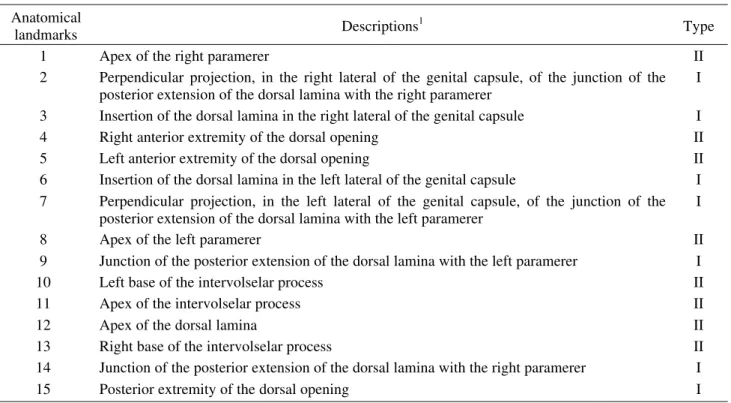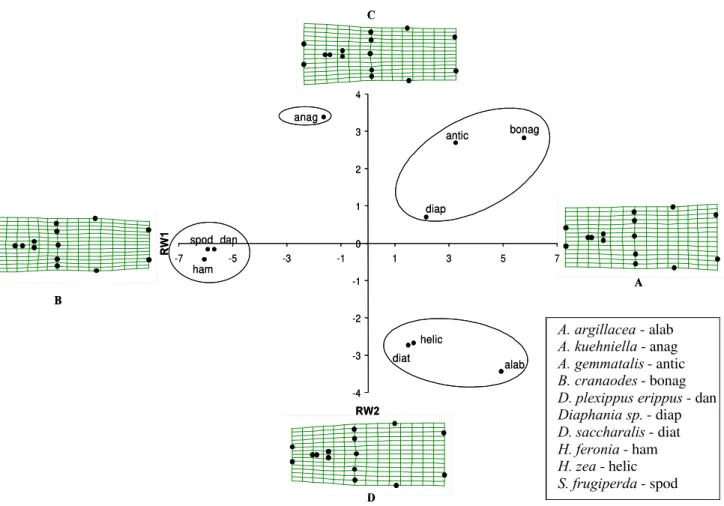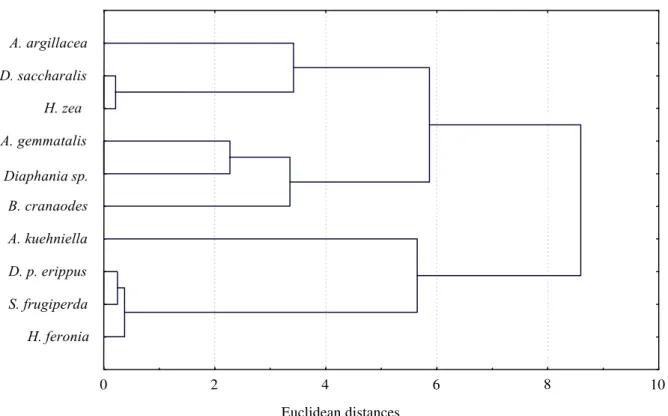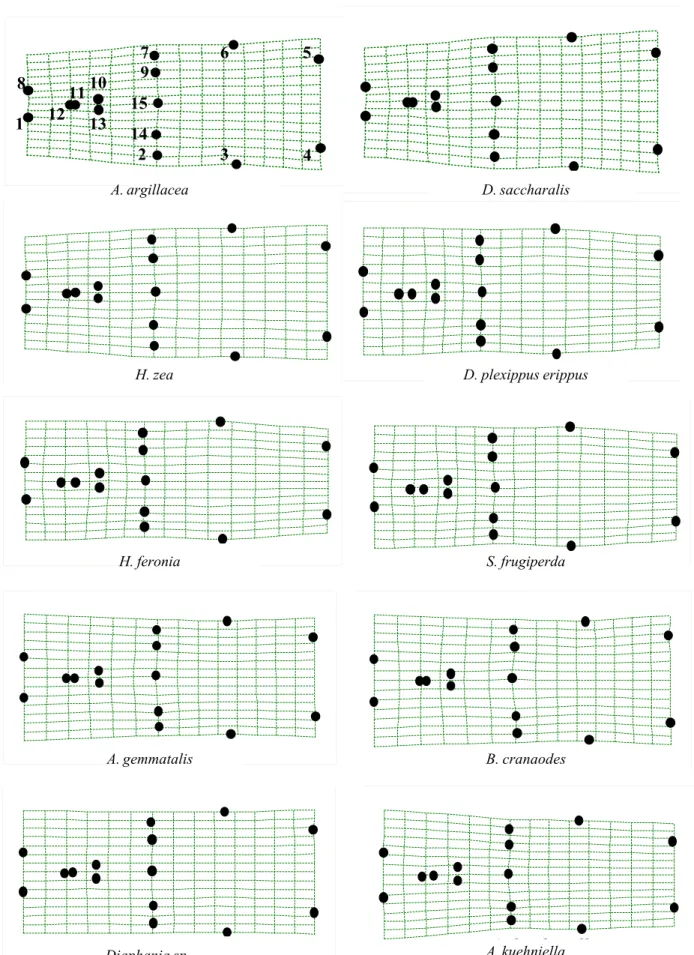SYSTEMATICS, MORPHOLOGY AND PHYSIOLOGY
Relative Warp Analysis to Study Morphological Variations in the Genital
Capsule of
Trichogramma
pretiosum
Riley (Hymenoptera:
Trichogrammatidae)
R
ANYSEB. Q
UERINO, R
EGINAC.B.
DEM
ORAESANDR
OBERTOA. Z
UCCHIDepto. Entomologia, Fitopatologia e Zoologia Agrícola, ESALQ/USP Av. Pádua Dias 11, 13418-900, Piracicaba, SP, e-mail: rbqsilva@carpa.ciagri.usp.br
Neotropical Entomology 31(2): 217-224 (2002)
Análise das Deformações Relativas no Estudo da Variação Morfológica na Cápsula Genital de
Trichogramma pretiosum Riley (Hymenoptera: Trichogrammatidae)
RESUMO - A influência dos hospedeiros sobre a morfologia da cápsula genital masculina de Trichogramma pretiosum Riley foi estudada por meio das análises de morfometria geométrica. Foram utilizados espécimes de T. pretiosum obtidos de 10 espécies de hospedeiros da ordem Lepidoptera. Inicialmente, estabeleceram-se os marcos anatômicos e foram obtidas as coordenadas cartesianas (x e y) de cada marco para as cápsulas genitais de todos os espécimes. Os marcos anatômicos transformados em coordenadas cartesianas foram analisados pelo método de superposição ortogonal pelos quadrados mínimos. Obteve-se uma configuração de consenso da cápsula genital para todos os espécimes e, em seguida, determinaram-se as deformações parciais e relativas. Quinze marcos geraram 24 deformações relativas para cada espécime. As ordenações das deformações relativas ( = 0), usando os componentes de forma, separaram T. pretiosum em quatro grupos segundo o hospedeiro (1 – Alabama argillacea (Hueb.), Helicoverpa zea (Bod.) e Diatraea saccharalis (Fabr.); 2 – Danaus plexippus erippus (Cramer), Hamadryas feronia (Linn.) e Spodoptera frugiperda (J.E. Smith); 3 – Anticarsia gemmatalis Hueb., Bonagota cranaodes Meirick e Diaphania sp. e 4 - Anagasta kuehniella (Zeller). Os dois primeiros eixos das deformações relativas explicaram 83,0% da variação total da forma dos espécimes. As principais diferenças na forma ocorreram na região anterior da extensão posterior da lâmina dorsal e da cápsula genital. Os resultados obtidos são iniciais e exploratórios, demonstrando que sutis diferenças na forma das cápsulas genitais masculinas de T. pretiosum podem ser detectadas por meio das análises de morfometria geométrica.
PALAVRAS-CHAVE: Insecta, morfometria geométrica, parasitóides de ovos.
ABSTRACT – The influence of the host on the morphology of the male genital capsule of Trichogramma pretiosum Riley was studied by geometric morphometric analysis. Specimens of the parasitoid obtained from 10 different Lepidoptera host species were used. Initially, landmarks were defined and Cartesian coordinates (x and y) for each landmark of the genital capsule of all specimens were obtained. The anatomic landmarks transformed to Cartesian coordinates were then analyzed by generalized orthogonal least-square procedure. Consensus configuration of the genital capsule for all specimens was obtained and partial and relative warps were determined. Fifteen landmarks generated 24 relative warps for each specimen. The ordination of the relative warps ( = 0), using shape components, separated T. pretiosum into four different hosts groups: (1 – Alabama argillacea (Hueb.), Helicoverpa zea (Bod.) and Diatraea saccharalis (Fabr.); 2 – Danaus plexippus erippus (Cramer), Hamadryas feronia (Linn.) and Spodoptera frugiperda (J.E. Smith); 3 – Anticarsia gemmatalis Hueb., Bonagota cranaodes Meirick and Diaphania sp. and 4 - Anagasta kuehniella (Zeller). The two first axes of the relative warps explained 83.0% of the total variation of the genital capsule shape of the specimens. The main difference was at the anterior region of the posterior extension of the dorsal lamina of the genital capsule. Although results obtained were initial and exploratory they have demonstrated that subtle shape differences in the male genital capsule can be detected by geometric morphometric analysis.
KEY WORDS: Insecta, geometric morphometrics, egg parasitoids.
α
Trichogramma pretiosum Riley, a parasitoid frequently used in biological control programs, has a wide distribution in the New World where it has been associated to 240 different hosts (Pinto 1998). This species presents low genetic variability and apparent morphological uniformity. Intraspecific variation, however, has been observed mainly in the male genitalia, which is an important parameter in the taxonomy of the genus Trichogramma. Studies carried out by Pinto et al. (1989) have shown that several characteristics of T. pretiosum were plastic and liable to ecophenotypic variation.
Studies on the host influence on the morphology of this parasitoid are scarce. It is known, however, that the parasitized species affects the size of the Trichogramma (Marston & Ertle 1973, Kazmer & Luck 1990, Bai et al. 1992, Liu et al. 1994). Most of the morphometric studies on this genus were based on linear measurements, which are certainly influenced by the size of the individuals sampled. Nevertheless, information about variations in the shape of the morphological structures on Trichogramma is not available.
The use of geometric morphometry on the study of shape has caused a revolution on the biometric analysis (Rohlf & Marcus 1993, Bookstein 1996), promoting advances on the knowledge and utilization of this technique in the early 90’s (Monteiro & Reis 1999). This method was developed to analyze the differences of shape among organisms based on anatomic landmarks defined by Cartesian coordinates (x and y). These coordinates are compared between specimens after removing the effects of size, position, and orientation, allowing to singly evaluating the differences in shape. Thus, it is possible to say that the shape of the object to be studied is contained within geometric properties that are not altered with changes in scale, translation and rotation (Rohlf 1996). These procedures are described in details in Rohlf & Bookstein (1990), Rohlf (1998a) and Monteiro & Reis (1999).
T. pretiosum presents morphological variation in the genital capsule that may be related to the hosts. The objective of this research was to carry out an exploratory study aiming
to detect variations on the shape of the genital capsule of this species using geometric morphometry by means of Relative Warp Analysis.
Material and Methods
Material Examined. The specimens used were obtained from the Trichogramma microscope slide collection of the Escola Superior de Agricultura Luiz de Queiroz – ESALQ, Piracicaba county, State of São Paulo, Brazil. Specimens of T. pretiosum from 10 different species of the order Lepidoptera were used (Table 1). The microscope slides were selected by choosing specimens presenting intact structures and suitable conditions to be drawn and the number of slides was defined by the availability of material in the collection. Only males were studied since the identification of Trichogramma is exclusively based on morphological structures of individuals of this sex.
Data Collection. Genital capsules of T. pretiosum specimens were drawn using a camera lucida (16x magnification) connected to a microscope (400x magnification). The drawings were ordinarily performed with the posterior extremity of the genitalia directed to the bottom margin of the paper and were than digitalized by the use of a scanner. A scale was used to standardize the drawings. Fifteen anatomical landmarks (representing homologous points) were defined in each drawing (Fig.1) in regions that better define the morphological differences observed in the structure. The Cartesian coordinates (x and y) of the landmarks were recorded in each drawing using the Tpsdig program (Rohlf 2000), and the types of anatomical landmarks were based on Bookstein (1991) (Table 2).
Geometric Morphometric Analysis. The Tpssmall program was used to quantify the variation in the shape of the genital capsules (Rohlf 1997). This procedure was adopted because when the variation in shape of a group of specimens is very large, statistical methods based on the approximation of the
Table 1. Hosts, collection sites and number of specimens of T. pretiosum used to study morphological variations in the genital capsule of this parasitoid using Relative Warp Analysis.
1 Laboratory rearing - with more than one year of multiplication of the parasitoids 2 First generation of T. pretiosum on the alternative host
3 PB = Paraíba; SP = São Paulo; PR = Paraná; RS = Rio Grande do Sul; MG = Minas Gerais; MS = Mato Grosso do Sul
Host insects (Lepidoptera) Collection sites (county - state) # of specimens
A. argillacea (Noctuidae) Juarez Távora-PB3 5
A. kuehniella1 (Pyralidae) Piracicaba-SP 14
A. gemmatalis (Noctuidae) Curitiba-PR 6
B. cranaodes (Tortricidae) Vacaria-RS 8
D. plexippus erippus2 (Nymphalidae) Piracicaba-SP 5
Diaphania sp.(Pyralidae) Viçosa-MG 3
D. saccharalis (Pyralidae) Rio Brilhante-MS 10
H. feronia2(Nymphalidae) Piracicaba-SP 3
H. zea (Noctuidae) Lavras-MG 12
tangential space cannot be used.
The configuration of the anatomical landmarks were superimposed by the least-squares method that transforms a configuration of landmarks, superimposing it on a configuration of reference (consensus) translating, scaling and rotating one of them so that the sum of squares of the distances between the corresponding points among configurations would be the least possible (Monteiro & Reis 1999). The configuration of references of the specimens by host were combined to analyze only the differences between the means.
The warps, represented by the thin-plate splines function, were determined and decomposed in shape descriptors which may have uniform components that describe stretching, compression or scission (global variation) and localized components corresponding to changes that occur at specific regions. The principal warps are the eigenvectors of the matrix of the deformation energy and each one describes a possible change in the shape applicable to the main configuration.
The superimposed configurations were then projected on the principal warps describing the differences in shape as deviations of the main configuration (Bookstein 1989, Rohlf 1993). The projections or scores generated indicated how much of each principal warp was needed to accomplish the deformations. The scores, also called partial warps, described each genital capsule of the specimens as a linear combination between principal warps and the standardized coordinates x and y for each anatomic landmark. These scores can be used in multivariate analysis (Rohlf 1993, Rohlf et al. 1996).
The relative warps, which are the main components of
Anatomical
landmarks Descriptions
1
Type
1 Apex of the right paramerer II
2 Perpendicular projection, in the right lateral of the genital capsule, of the junction of the posterior extension of the dorsal lamina with the right paramerer
I
3 Insertion of the dorsal lamina in the right lateral of the genital capsule I
4 Right anterior extremity of the dorsal opening II
5 Left anterior extremity of the dorsal opening II
6 Insertion of the dorsal lamina in the left lateral of the genital capsule I 7 Perpendicular projection, in the left lateral of the genital capsule, of the junction of the
posterior extension of the dorsal lamina with the left paramerer
I
8 Apex of the left paramerer II
9 Junction of the posterior extension of the dorsal lamina with the left paramerer I
10 Left base of the intervolselar process II
11 Apex of the intervolselar process II
12 Apex of the dorsal lamina II
13 Right base of the intervolselar process II
14 Junction of the posterior extension of the dorsal lamina with the right paramerer I
15 Posterior extremity of the dorsal opening I
Table 2. Descriptions and types of anatomical landmarks of the male genital capsule of T. pretiosum.
1See Pinto (1998) for definition of morphological terms.
5, landmarks 2 to 7) and dilation at the posterior region (Fig. 5, landmarks 1 and 8).
Based on the grids of relative warps of T. pretiosum it was found that the differences in shape occurred mainly at the anterior region of the posterior extension of the dorsal lamina, at the insertion of the dorsal lamina and at the anterior region of the genital capsule.
Discussion
The relative warps detected the association between T. pretiosum and each one of the different hosts, concerning shape of the genital capsule. The host influence on the biology of theses parasitoids is widely discussed in the literature (Marston & Ertle 1973, Kazmer & Luck 1990 and Corrigan & Laing 1994) and the majority of papers discuss the influence of the host species on the size of the parasitoid (e.g. Grenier et al. 2001). However, morphological changes caused by the hosts have not been reported.
Results obtained in the present research work do not allow inferences of the size of the host egg on the variation in shape of the genital capsule. However, information from literature indicates that these alterations can occur. Specimens of T. pretiosum obtained from bigger size and volume eggs [example: D. saccharalis (size: 1136.0 µm x Figure 2. Configuration of anatomical landmarks of specimens of T. pretiosum superimposed by least-square procedure. The lines connect landmarks of the mean configuration (black circles) and the variation in shape can be observed around each landmark (clear circles).
the matrix that combine scores of partial warps and uniform components, were obtained using the matrix of the scores of the partial warps. T. pretiosum ordination graphs and grids of the warps associated to each computed axis were built. In order to have all the partial warps is the same scale of variation, values of = 0 were established in the computation of the scores of partial warps. This procedure is the most suitable for exploratory and taxonomic studies (Rohlf 1993) since the values displace the axis of higher variation of shape to regions with bigger or smaller location (Monteiro & Reis 1999).
The analyses of superimposing and relative warps were performed using the Tpsrelw program (Rohlf 1998b). All programs of the “TPS” series used in this research work are freeware (http://life.bio.sunysb.edu/morph).
Results
Data provided by generalized orthogonal least-square superimposition procedure of T. pretiosum genital capsules have shown variation in shape due to differences in the samples. This can be observed by the dispersion of the ponts related to the specimens from 10 different hosts (clear circles) as compared to the average shape (black circles). The largest variation in shape occurred at the anterior region of the genital capsule (Fig. 2).
The 15 anatomic landmarks generated 24 relative warps for each T. pretiosum sample. Analysis of relative warps, using shape components, ordered groups of T. pretiosum (Fig. 3). The first two axes of relative warps explained 64.3% and 18.7%, i.e., 83.0% of the total variation of the genital capsules shape of the specimens, dismissing the use of other axes.
Trichogramma pretiosum was ordered in relation to the total differences (global and localized) in the shape of the genital capsule (Fig. 3). The grids of hypothetical warps indicate that the parasitoids obtained from hosts located on a given position in the axes may present warps similar to those of the nearest hypothetical grid (Fig. 3 A – D).
Four groups of T. pretiosum were determined (Fig. 4). One group was obtained from Alabama argillacea (Hueb.), Diatraea saccharalis (Fabr.) and Helicoverpa zea (Bod.) that presented more dilated relative warp grids at the posterior extension of the dorsal lamina (Fig. 5, landmarks 2 and 7) and at the anterior region of the genital capsule (Fig. 5, landmarks 3 to 6), indicating that the specimens of this group have genital capsules relatively wider. Other group aggregated T. pretiosum specimens obtained from Danaus plexippus erippus (Cramer), Hamadryas feronia (Linn.) and Spodoptera frugiperda (J.E. Smith), with narrower grids, indicating that these specimens present narrower genital capsules. T. pretiosum obtained from Anticarsia gemmatalis Hueb., 1818, Bonagota cranaodes Meirick and Diaphania sp. comprised a little warped grid group, similar to each other, indicating that these specimens present genital capsule in an intermediate position in relation to the other groups. The specimens of T. pretiosum obtained from Anagasta kuehniella (Zeller) presented a grid of relative warp with a narrowing at the anterior region (Fig.
α
826.9 µm ) (Consoli 1997)] presented genital capsule relatively larger than those specimens obtained from smaller eggs hosts such as the ones of A. kuehniella (520.7 µm x 289.8 µm ; 0.023 mm3), S. frugiperda (454.9 µ
m x 390.2
µm ; 0.036 mm3) and A. gemmatalis (628.2 µm x 428.0 µm ;
0.089 mm3)(Consoli 1997) that presented relatively smaller
width at the genital capsule.
T. pretiosum presents intra-specific variation, i.e., many morphological characteristics are plastic and liable to ecophenotipic variation (Pinto et al. 1989, Pinto & Stouthamer 1994). In this work, however, the reduced number of specimens obtained from each different host did not allow a multivariate analysis correlating intra- and inter-population variations. By means of sequencing the ITS2 region of the rDNA, Ciociola Jr. et al. (2001) compared specimens of T. pretiosum obtained from different hosts originated from different regions of Brazil and found that small genetic differences exist between populations but the sequencing pattern within the species remained the same.
Several factors, either genetic or possibly due to host effects (size or nutritional value of the egg), may interact causing differences in shape. To identify these factors, however, more specific studies are needed. Further studies aiming this goal should be carried out trying to correlate these causes to environmental and genetic variables. Although results here obtained were preliminary and exploratory they have demonstrated that the geometric morphometry, using Relative Warps Analysis, can become an important tool in taxonomic studies of the genus Trichogramma.
Acknowledgments
To Fundação de Amparo a Pesquisa do Estado de São Paulo (FAPESP for granting the scholarship to the first author (process # 98/01979-9) and to Professor Dr. Leandro Rabello Monteiro (UNEF) for support and suggestions in reviewing the manuscripts.
A B D C -4 -3 -2 -1 0 1 2 3 4
-7 -5 -3 -1 1 3 5 7
RW2 RW1 alab helic diat bonag antic diap anag dan ham spod
A. argillacea - alab A. kuehniella - anag A. gemmatalis - antic B. cranaodes - bonag D. plexippus erippus - dan Diaphania sp. - diap D. saccharalis - diat H. feronia - ham H. zea - helic S. frugiperda - spod
A B D C -4 -3 -2 -1 0 1 2 3 4
-7 -5 -3 -1 1 3 5 7
RW2 RW1 alab helic diat bonag antic diap anag dan ham spod
A. argillacea - alab A. kuehniella - anag A. gemmatalis - antic B. cranaodes - bonag D. plexippus erippus - dan Diaphania sp. - diap D. saccharalis - diat H. feronia - ham H. zea - helic S. frugiperda - spod
A. argillacea - alab A. kuehniella - anag A. gemmatalis - antic B. cranaodes - bonag D. plexippus erippus - dan Diaphania sp. - diap D. saccharalis - diat H. feronia - ham H. zea - helic S. frugiperda - spod
Figure 3. Relative Warps (RW) for values of = 0 of T. pretiosum specimens obtained from 10 different Lepidoptera hosts. A-variation in the shape of the genital capsule foreseen as positive deviations of the mean in the axis of relative warps 1. B-variation in the shape of the genital capsule foreseen as negative deviations of the mean in the axis of relative warps1. C- variation in the shape of the genital capsule foreseen as positive deviations of the mean in the axis of the relative warps 2. D-variation in the shape of the genital capsule foreseen as negative deviations of the mean in the axis of relative warps 2. (Genitalia apex to the left; anatomical landmarks see Fig. 1).
Literature Cited
Bai, B., R.F. Luck, L. Forster & B. Stephens. 1992. The effect of host size on quality attributes of the egg parasitoid, Trichogramma pretiosum Riley. Entomol. Exp. Appl. 64: 37-48.
Bookstein, F.L. 1989. “Size and shape”: a comment on semantics. Syst. Zool. 38: 173-180.
Bookstein, F.L. 1991. Morphometrics tools for landmarks data: geometry and biology. New York, Cambridge University Press, 435p.
Bookstein, F.L. 1996. Biometrics, biomathematics and the morphometric synthesis. Bull. Math. Biol. 58: 313-365. Ciociola Jr., A.I., R.A. Zucchi & R. Stouthamer. 2001. Molecular key to seven brazilian species of Trichogramma (Hymenoptera: Trichogrammatidae) using sequences of the ITS2 region and restriction analysis. Neotrop. Entomol. 30: 259-262.
Cônsoli, F.L. 1997. Criação in vitro de Trichogramma galloi Zucchi, 1988 e Trichogramma pretiosum Riley, 1879 (Hymenoptera: Trichogrammatidae): desenvolvimento de um ovo artificial e aprimoramento das dietas artificiais. Tese de doutorado, ESALQ, Piracicaba, 153p.
Corrigan, J.E. & J.E. Laing. 1994. Effects of the rearing host species and the host species attacked on performance by Trichogramma minutum Riley (Hymenoptera: Trichogrammatidae). Environ. Entomol. 23: 755-760. Grenier, S., G. Grille, C. Basso & B. Pintureau. 2001.
Effects of the host species and the number of parasitoids per host on the size of some Trichogramma species (Hymenoptera: Trichogrammatidae). Biocontrol Sci. Techn.11: 21-26.
Kazmer, D.J. & R.F. Luck. 1990. Female body size, fitness and biological control quality: field experiments with Trichogramma pretiosum. Les Colloques de l’INRA. 56: 37-40.
Liu, S.S., G.M. Zhang, Z.H. Shi & F. Zhang. 1994. The effect of the rearing host species and host age on the parasitization of the Asian corn borer, Ostrinia furnacalis, by Trichogramma dendrolimi. Les Colloques de l’INRA 73: 87-90.
Marston, N. & I.R. Ertle. 1973. Host influences on the bionomics of Trichogramma minutum. Ann. Entomol. Soc. Am. 66: 1155-1162.
Monteiro, L.R. & S.F. dos Reis. 1999. Princípios de morfometria geométrica. Ribeirão Preto, Holos Editora, 198p.
Euclidean distances
H. feronia S. frugiperda D. p. erippus A. kuehniella B. cranaodes Diaphania sp. A. gemmatalis
H. zea D. saccharalis
A. argillacea
0 2 4 6 8 10
A. kuehniella
A. gemmatalis
B. cranaodes
D. plexippus erippus
Diaphania
sp.
D. saccharalis
H. feronia
H. zea
S. frugiperda
A. argillacea
1
2
3
4
5
6
7
8
10
9
11
12
13
14
15
A. kuehniella
A. gemmatalis
B. cranaodes
D. plexippus erippus
Diaphania
sp.
D. saccharalis
H. feronia
H. zea
S. frugiperda
A. argillacea
1
2
3
4
5
6
7
8
10
9
11
12
13
14
15
A. argillacea D. saccharalis
H. zea D. plexippus erippus
H. feronia S. frugiperda
A. gemmatalis B. cranaodes
Diaphania sp. A. kuehniella
Figure 5. Grids of relative warps ( = 0) with the average shape of the genital capsules of T. pretiosum specimens obtained from 10 different Lepidoptera hosts (genitalia apex to the left; anatomical landmarks 1 to 15, see Fig. 1).
Pinto, J.D. 1998. Systematics of the North American species of Trichogramma Westwood (Hymenoptera: Trichogrammatidae). Mem. Entomol. Soc. of Wash. Allen Press Inc.,Washington D.C., 287p.
Pinto, J.D. & R. Stouthamer. 1994. Systematics of the Trichogrammatidae with emphasis on Trichogramma, p.1-36. In E. Wajnberg & S.A. Hassan (eds.), Biological control with egg parasitoids. Wallingford, CAB International, 286p.
Pinto, J.D., R.K. Velten & G.R. Platner. 1989. Phenotypic plasticity and taxonomic characters in Trichogramma (Hymenoptera: Trichogrammatidae). Ann. Entomol. Soc. Am. 84: 414-425.
Rohlf, F.J. 1993. Relative warps analysis and an example of its application to mosquito wings, p. 131-159. In L.F. Marcus, E. Bello & A. Garcia-Valdecasas (eds.), Contributions to morphometrics. Madrid, Museu Nacional de Ciencias Naturales, 264p.
Rohlf, F.J. 1996. Morphometric spaces, shape components, and the effects of linear transformations, p. 117-130. In L.F. Marcus, M. Corti, A. Loy, G.J.P. Naylor & D.E. Slice (eds.), Advances in morphometrics. NATO ASI Serie A, Life Sciences, 284. New York, Plenum Publishing Corp., 587p.
Rohlf, F.J. 1997. TPSSMALL, version 1.17. A program to test the variation in shape among a set of specimens.
Department of Ecology and Evolution, State University of New York, Stony Brook, NY.
Rohlf, F.J. 1998a. On applications of geometric morphometrics to studies of ontogenia and phylogeny. Sys. Biol. 47: 147-158.
Rohlf, F.J. 1998b. TPSRELW, version 1.18. A program to performs a relative warp analysis. Department of Ecology and Evolution, State University of New York, Stony Brook, NY.
Rohlf, F.J. 2000. TPSDIG, version 1.20. A program for digitizing landmarks and outlines for geometric morphometric analyses. Department of Ecology and Evolution, State University of New York, Stony Brook, NY.
Rohlf, F.J. & F.L. Bookstein (eds.) 1990. Proceedings of the Michigan Morphometrics Workshop. Special Publication Number 2, The University of Michigan Museum of Zoology, 380p.
Rohlf, F.J. & L.F. Marcus. 1993. A revolution in morphometrics. Trends Ecol. Evol. 8: 129-132. Rohlf, F.J., A. Loy & M. Corti. 1996. Morphometric



